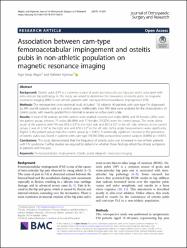| dc.contributor.author | Akgün, Ayşe Serap | |
| dc.contributor.author | Ağırman, Mehmet | |
| dc.date.accessioned | 2019-12-23T12:10:27Z | |
| dc.date.available | 2019-12-23T12:10:27Z | |
| dc.date.issued | 2019 | en_US |
| dc.identifier.citation | Akgün, A. S. ve Ağırman, M. (2019). Association between cam-type femoroacetabular impingement and osteitis pubis in non-athletic population on magnetic resonance imaging. Journal of Orthopaedic Surgery and Research, 14(1). https://doi.org/10.1186/s13018-019-1368-6 | en_US |
| dc.identifier.uri | https://doi.org/10.1186/s13018-019-1368-6 | |
| dc.identifier.uri | https://hdl.handle.net/20.500.12511/4611 | |
| dc.description.abstract | Background Osteitis pubis (OP) is a common source of groin and extra-articular hip pain and is associated with intra-articular hip pathology. In this study, we aimed to determine the prevalence of osteitis pubis on magnetic resonance imaging (MRI) in non-athletic patients with cam-type femoroacetabular impingement (FAI). Methods This retrospective cross-sectional study included 178 subjects: 90 patients with cam-type FAI diagnosed by MRI and 88 subjects used as a control group. Additionally, their MRI data were analyzed for the characteristics of osteitis pubis, with severity graded from minimal to severe on a four-point scale. Results A total of 98 patients and 88 controls were studied. Seventy-two males (80%) and 18 females (20%) were the patient group, whereas 71 males (80.68%) and 17 females (19.32%) were the control group. The mean alpha angle of the patients with FAI was 65.8 +/- 3.3 degrees in the right side and 66.2 +/- 3.2 degrees in the left side, whereas in the control group, it was 47 +/- 5.6 degrees in the right side and 47.8 +/- 5.2 degrees in the left side. Alpha angle measurements were significantly higher in the patient group than the control group (p < 0.001). A statistically significant increase in the prevalence of osteitis pubis was found in patients with cam-type FAI (45.56%) compared to control subjects (5.68%) (p < 0.001). Conclusions This study demonstrated that the frequency of osteitis pubis was increased in non-athletic patients with FAI syndrome. Further studies are required to determine whether these findings reflect the clinical symptoms in patients with hip pain. | en_US |
| dc.language.iso | eng | en_US |
| dc.publisher | BMC | en_US |
| dc.rights | info:eu-repo/semantics/openAccess | en_US |
| dc.rights | Attribution 4.0 International | * |
| dc.rights.uri | https://creativecommons.org/licenses/by/4.0/ | * |
| dc.subject | Femoroacetabular Impingement | en_US |
| dc.subject | Osteitis Pubis | en_US |
| dc.subject | Magnetic Resonance Imaging | en_US |
| dc.title | Association between cam-type femoroacetabular impingement and osteitis pubis in non-athletic population on magnetic resonance imaging | en_US |
| dc.type | article | en_US |
| dc.relation.ispartof | Journal of Orthopaedic Surgery and Research | en_US |
| dc.department | İstanbul Medipol Üniversitesi, Tıp Fakültesi, Dahili Tıp Bilimleri Bölümü, Fizik Tedavi ve Rehabilitasyon Ana Bilim Dalı | en_US |
| dc.department | İstanbul Medipol Üniversitesi, Tıp Fakültesi, Dahili Tıp Bilimleri Bölümü, Radyoloji Ana Bilim Dalı | en_US |
| dc.authorid | 0000-0002-9610-2209 | en_US |
| dc.authorid | 0000-0003-1757-1814 | en_US |
| dc.identifier.volume | 14 | en_US |
| dc.identifier.issue | 1 | en_US |
| dc.relation.publicationcategory | Makale - Uluslararası Hakemli Dergi - Kurum Öğretim Elemanı | en_US |
| dc.identifier.doi | 10.1186/s13018-019-1368-6 | en_US |
| dc.identifier.wosquality | Q2 | en_US |
| dc.identifier.scopusquality | Q2 | en_US |



















